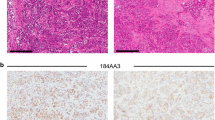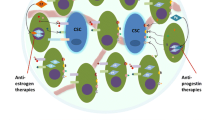Summary
Hypothesis. Among premenopausal women, both post-resection metastatic potential and tumor growth rate are influenced by the menstrual cycle. There is strong support for the former in large retrospective studies of surgical resection timing within the menstrual cycle and the following experiments were conducted to critically evaluate the latter. Methods. We studied a transplantable breast cancer of C3HeB/FeJ mice (3 studies), and a transplantable methylcholantherene A induced sarcoma of CD2F1 mice (2 studies). We concurrently measured local cancer size and estrous cycle stage up to twice and at least once each day. There is a natural individual variability in the average length of normal estrus (3-1/2 to 7 days) cycle in mice. We assessed the effect of the cycle stage and cycle duration on tumor size. Results. We found identical estrous cycle stage coordination of cancer size, and identical effects of cycling frequency across all studies in each of these two tumors, both of which express both estrogen receptor alpha and progesterone receptor. Little or no change in cancer size occurs during proestrus (preovulatory phase) and estrus (periovulatory phase); tumor size increases several fold during diestrus (post-ovulatory phase); and the tumor shrinks partially as the next proestrus phase is approached. Across both mouse strains and tumor types, mice whose average cycle length is briefer (faster cyclers), have slower average tumor growth rate than those with longer cycles (slower cyclers) who have faster tumor growth rates. Conclusion. The virtually identical modulation of tumor size and cancer growth rate, in each of two very different transplantable cancers (one, classically sex-hormone-dependent, and the other, never previously recognized as hormone dependent) growing in two unrelated inbred mouse strains, indicates that the fertility cycle related host factors affect cancer size and growth rate. These experimental findings suggest that cancer cell proliferation of both breast and non-breast cancers in premenopausal women may be meaningfully coordinated by the menstrual cycle. If this proves to be the case, then any therapeutic strategy targeting proliferating cancer cells should be most effective against cancer of cycling women when given during the follicular phase of their menstrual cycles.
Similar content being viewed by others
References
H Adami P Sparen R Bergstrom L Holmberg U Krusemo J Ponten (1989) ArticleTitleIncreasing survival trend after cancer diagnosis in Sweden 1960-1984 J Natl Cancer Inst 81 1640–1647 Occurrence Handle1:STN:280:DyaK3c%2Fht1altA%3D%3D Occurrence Handle2795692
H Adami R Bergstrom L Holmberg L Klareskog I Persson J Ponten (1990) ArticleTitleThe effect of female sex hormones on cancer survival; a register-based study in patients younger than 20 years at diagnosis JAMA 263 2189–2193 Occurrence Handle10.1001/jama.263.16.2189 Occurrence Handle1:STN:280:DyaK3c3gsVOmtg%3D%3D Occurrence Handle2319685
E Knobil J Neill (Eds) (1994) The Physiology of Reproduction Raven Press New York
EA Whelan DP Sandler JL Root KR Smith CR Weinberg (1994) ArticleTitleMenstrual cycle patterns and risk of breast cancer Am J Epidemiol 140 IssueID12 1081–90 Occurrence Handle1:STN:280:DyaK2M%2FptFagtQ%3D%3D Occurrence Handle7998590
C Magnusson I Persson J Baron A Ekbom R Bergstrom H Adami (1999) ArticleTitleThe role of reproductive factors and use of oral contraceptives in the aetiology of breast cacner in women aged 50 to 74 years Int J Cancer 80 231–236 Occurrence Handle10.1002/(SICI)1097-0215(19990118)80:2<231::AID-IJC11>3.0.CO;2-R Occurrence Handle1:CAS:528:DyaK1MXhtlajtg%3D%3D Occurrence Handle9935204
W Lindsey T Gupta C Beattie (1981) ArticleTitleInfluence of the estrous cycle during carcinogen exposure on nitrosomethylurea-induced rat mammary carcinoma Cancer Res 41 3857–3862 Occurrence Handle1:CAS:528:DyaL3MXlvVajtrs%3D Occurrence Handle7197191
T Ratko C Beattie (1995) ArticleTitleEstrous cycle modification of rat mammary tumor induction by a single dose of N-methyl-N-nitrosourea Cancer Res 45 3042–3047
H Nagasawa R Yanai H Taniguchi (1976) ArticleTitleImportance of mammary gland DNA synthesis on carcinogen-induced mammary tumorigenesis Cancer Res 36 2223–2226 Occurrence Handle1:CAS:528:DyaE28XltVGjtrc%3D Occurrence Handle945123
R Pascual S Hwang S Swanson M Bauzon R Guzman S Nandi (1994) ArticleTitlec-Has-ras activation in MNU induced rat mammary cancers is regulated by ovarian hormones Proc Amer Assoc Cancer Res 35 262
B Fisher ER Fisher (1959) ArticleTitleExperimental evidence in support of the dormant tumor cell Science 130 918–919 Occurrence Handle1:STN:280:DyaF3c7ktlKmuw%3D%3D Occurrence Handle13823184
K Bove DW Lincoln PA Wood WJ Hrushesky (2002) ArticleTitleFertility cycle influence on surgical breast cancer cure Breast Cancer Res Treatment 75 IssueID1 65–72 Occurrence Handle10.1023/A:1016543222323 Occurrence Handle1:CAS:528:DC%2BD38Xls1Cmsr4%3D
S You W Li M Kobayashi Y Xiong WJ Hrushesky PA Wood (2004) ArticleTitleCreation of a stable mammary tumor cell line that maintains fertility cycle tumor biology of the parent tumor In Vitro Cell Dev Biol Anim 40 IssueID3 2004 Occurrence Handle10.1290/1543-706X(2004)40<187:COASMT>2.0.CO;2
WJM Hrushesky SA Gruber RB Sothern et al. (1988) ArticleTitleNatural killer cell activity: Age, estrous- and circadian-stage dependence and inverse correlation with metastatic potential J Nat Cancer Inst 80 1232–1237 Occurrence Handle1:STN:280:DyaL1czjtlSgsQ%3D%3D Occurrence Handle3262168
WJM Hrushesky AZ Bluming SA Gruber RB Sothern (1989) ArticleTitleMenstrual influence on surgical cure of breast cancer Lancet ii 949–952 Occurrence Handle10.1016/S0140-6736(89)90956-2
W Hrushesky (1996) ArticleTitleBreast cancer, timing of surgery, and the menstrual cycle: call for prospective trial J Women’s Health 5 IssueID6 555–565 Occurrence Handle10.1089/jwh.1996.5.555
A Hagen W. Hrushesky (1998) ArticleTitleMenstrual timing of breast cancer surgery Am J Surg 104 245–261 Occurrence Handle10.1016/S0002-9610(97)00294-8
RR DN Love NV Dinh T Shen TZ Havighurst DC Allred et al. (2002) ArticleTitleMastectomy and oophorectomy by menstrual cycle phase in women with operable breast cancer J Nat Cancer Inst 94 662–669 Occurrence Handle11983754
Hrushesky W: Letter to the Editor RE: Mastectomy and Oophorectomy by Menstrual Cycle Phase in Women with Operable Breast Cancer (Love, et al). J Nat Cancer Inst 94(22): 1720–1721, 2002
HV Ratajczak R Sothern WJM Hrushesky (1986) Single cosinor analysis of vaginal smear cell types quantifies mouse estrous cycle and its alteration by mammalian adenocarcinoma A Reinberg M Smolensky G Labrecque (Eds) Ann. Rev. Chronopharm Pergam Press New York 223–226
P Wood S Waldo W Hrushesky (1998) Lack of major effect of tumor growth and fluoropyrimidine treatment upon maintenance of fertility cycling Y Touito (Eds) Biological Clocks: Mechanisms and Applications Elsevier Amsterdam 507–510
A Cooper (1836) Practice and Principles of Surgery E. Cox, St. Thomas’s St., Southwark London
Beatson G. PhD Dissertation, Beatson Cancer Institute. Beatson Library, Glassow, Scotland
G Beatson (1896) ArticleTitleOn the treatment of inoperable cases of carcinoma of the mamma: Suggestions for a new method of treatment with illustrative cases Lancet ii 104–107
B Fisher N Gunduz EA Saffer (1983) ArticleTitleInfluence of the interval between primary tumor removal and chemotherapy on kinetics and growth metastases Cancer Res 43 1488–1492 Occurrence Handle1:CAS:528:DyaL3sXhslaktrY%3D Occurrence Handle6831397
B Fisher N Gunduz J Coyle C Rudock E Saffer (1989) ArticleTitlePresence of a growth-stimulating factor in serum following primary tumor removal in mice Cancer Res 49 1996–2001 Occurrence Handle1:CAS:528:DyaL1MXitFSisbY%3D Occurrence Handle2702641
I Fentiman W Gregory M Richards (1994) ArticleTitleEffects of menstrual phase on surgical treatment of breast cancer Lancet 344 402 Occurrence Handle10.1016/S0140-6736(94)91428-1 Occurrence Handle1:STN:280:DyaK2czivVyhsA%3D%3D Occurrence Handle7914318
VJ Lampl M ML Johnson (1992) ArticleTitleSaltation and Stasis: A Model of Human Growth Science 258 801–803 Occurrence Handle1439787
T Anderson S Battersky R King J Going (1989) ArticleTitleOral contraceptive use influences resting breast proliferation Hum Pathol 20 1139–1144 Occurrence Handle10.1016/0046-8177(89)90049-X Occurrence Handle1:STN:280:DyaK3c%2FnslertQ%3D%3D Occurrence Handle2591943
D Kawaguchi S Fujii I Konishi Y Nanbu H Nonagaki T Mori (1989) ArticleTitleMitotic activity in uterine leiomyomas during the menstrual cycle Am J Obstet Gynecol 160 637–641 Occurrence Handle1:STN:280:DyaL1M7ptVyktw%3D%3D Occurrence Handle2929683
S You XiongY M Kobayashi P Wood S Bickley M Simu J Quiton WJ Hrushesky (2003) ArticleTitleTumor cell circadian clock genes are rhythmically expressed in coordination with rhythmic circadian growth and, thereby, may represent new therapeutic targets Clin. Cancer Res 9 IssueID16 6126s
K Hori Q-H Zhang H-C Li S Saito (1995) ArticleTitleVariation of growth rate of a rat tumour during a light-dark cycle: correlation with circadian fluctuations in tumour blood flow Br J of Cancer 71 1163–1168 Occurrence Handle1:STN:280:DyaK2M3pvVKmuw%3D%3D
W Hrushesky D Lannin E Haus (1998) ArticleTitleEvidence for an ontogenetic basis for circadian coordination of cancer cell proliferation J Nat Cancer Inst 90 IssueID19 1480–1484 Occurrence Handle10.1093/jnci/90.19.1480 Occurrence Handle1:STN:280:DyaK1cvkslejuw%3D%3D Occurrence Handle9776414
Author information
Authors and Affiliations
Corresponding author
Rights and permissions
About this article
Cite this article
Wood, P.A., Hrushesky, W.J. Sex cycle modulates cancer growth. Breast Cancer Res Treat 91, 95–102 (2005). https://doi.org/10.1007/s10549-005-8269-6
Issue Date:
DOI: https://doi.org/10.1007/s10549-005-8269-6




